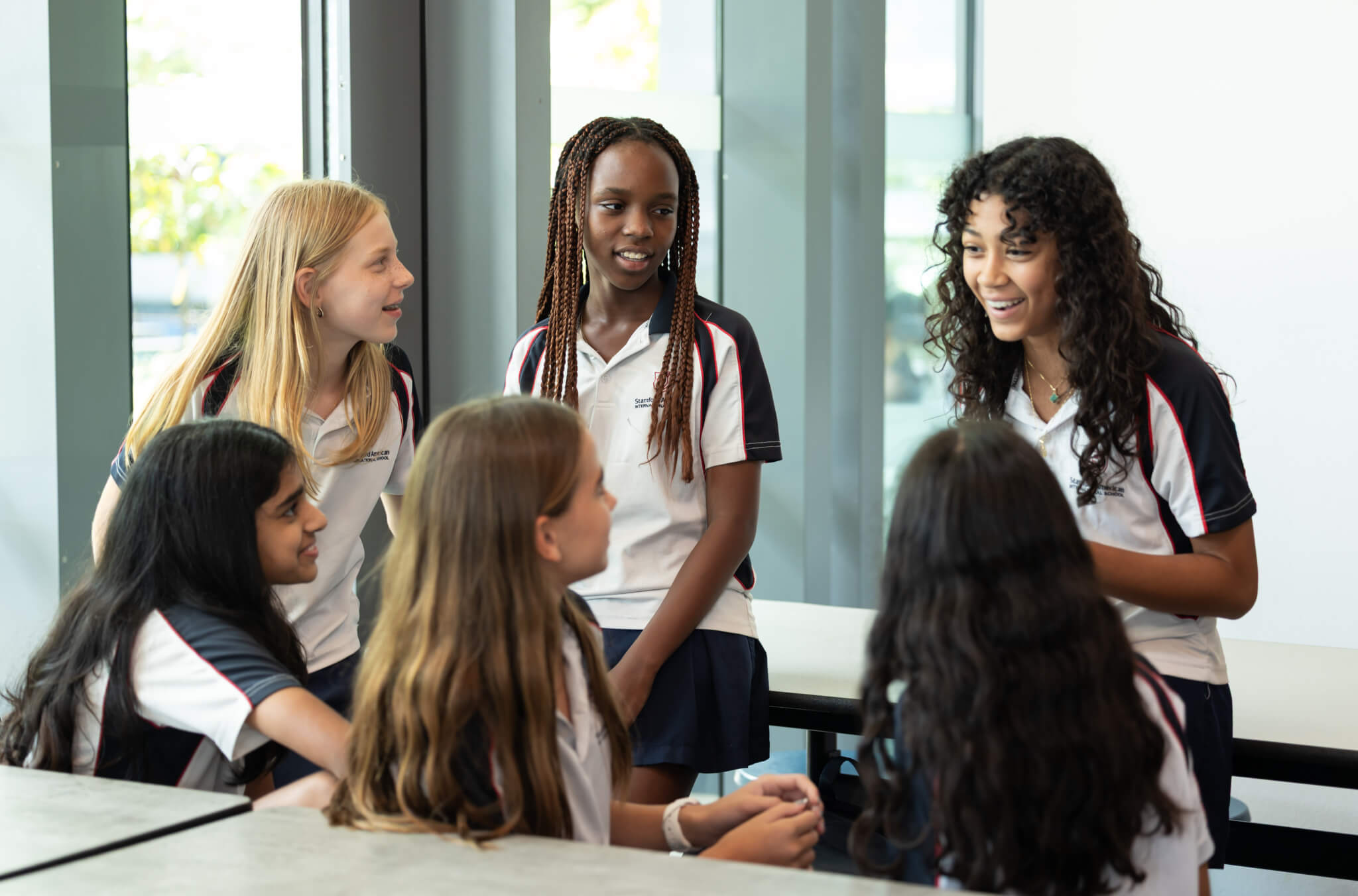Self-esteem reflects how individuals perceive their value and self-worth. It begins to develop early in life and is influenced by daily experiences, such as parental approval, support from peers, and personal achievements. Middle school, a period marked by physical, emotional, and social changes, is a crucial time for adolescents, typically in their early teens, as they strive for independence, discover their strengths, and seek acceptance among their peers. At Stamford American International School, we recognize the importance of building self-esteem during these formative years and actively foster confidence in middle schoolers through a supportive environment. Beyond its impact on academic performance, self-esteem is also a key indicator of overall well-being and can serve as a protective factor against mental health challenges.
Parents, teachers, and schools can leverage the unique opportunities of the middle school years to help students build positive self-esteem and confidence. This article serves as a guide for these key stakeholders, offering strategies to nurture self-esteem in middle schoolers that can be easily integrated into the home, classroom, and school setting.
Summary of Contents:
How Can Parents Support the Development of Their Middle Schoolers’ Self-Esteem?
- Encourage and Praise Effort, Not Just Achievements
- Listen to Children’s Concerns and Validate Their Feelings
- Teach Problem-Solving and Decision-Making Skills
- Set Realistic Expectations and Avoid Excessive Criticism
- Encourage Hobbies to Build Skills and Interests
- Promote Healthy Habits That Can Lead to a Positive Self-image
How Can Middle School Teachers Turn Their Classroom into a Healthy Space for Building Confidence?
- Foster a Supportive and Inclusive Classroom Environment
- Give Constructive Feedback and Recognize Individual Strengths
- Encourage Students to Participate and Take on Leadership Roles
- Teach Social-Emotional Skills in the Classroom
How Can Parents Support the Development of Their Middle Schooler’s Self-Esteem?
Parents play a pivotal role in shaping their middle school-aged children’s self-esteem. By fostering a supportive home environment, they can help their children build the confidence needed to tackle challenges and develop a positive self-image. Here are some strategies parents can implement to support this goal:
Encourage and Praise Effort, Not Just Achievements
Rather than emphasizing accomplishments, parents should focus on recognizing and praising their children’s efforts. Acknowledging hard work and persistence reinforces the idea that success goes beyond the final outcome. For example, instead of saying, “You’re so smart,” parents can say, “I can see you worked really hard on that project.” This approach promotes a growth mindset, encouraging children to embrace challenges and view setbacks as opportunities to learn and improve.
Listen to Children’s Concerns and Validate Their Feelings
It’s normal for middle school students to experience emotional ups and downs, self-doubt, and peer pressure. While these struggles are typical at this stage, parents should take the time to listen to their children’s concerns and validate their feelings.
While it may be tempting to dismiss their worries with a reassuring “You’ll be fine,” it’s more helpful to respond with, “I understand why you feel that way—let’s talk about it.” By fostering open dialogue, parents can build trust, reinforce their children’s self-worth, and show them that their thoughts and emotions are valued.
Teach Problem-Solving and Decision-Making Skills
As adolescents seek independence and opportunities to excel, parents can support their personal growth by helping them develop problem-solving and decision-making skills.
One way to do this is by adopting an advisory role and allowing children to navigate everyday challenges on their own. For example, if a child struggles with a school project, instead of offering a solution or immediately enrolling them in an academic support program, a parent can ask, “What do you think your options are?” Encouraging children to weigh their choices, consider consequences, and take responsibility for their decisions fosters a sense of capability and independence.
Set Realistic Expectations and Avoid Excessive Criticism
While it’s important to set high standards, parents should also be mindful that unrealistic expectations can lead to feelings of inadequacy. Parents should encourage their children to do their best while emphasizing that perfection is not the goal.
This can be achieved by replacing demands like, “You should always get top grades,” with a more supportive approach such as, “Do your best and focus on learning.” Additionally, providing constructive feedback that emphasizes improvement over fault is key. For example, instead of criticizing a mistake, parents can ask, “What do you think you can do differently next time?” to foster growth without undermining their children’s self-esteem.
Encourage Hobbies to Build Skills and Interests
Engaging in hobbies and co-curricular activities helps children uncover their strengths and develop new skills, while also providing opportunities to make friends. Parents can support this exploration by exposing their children to activities like sports, performing arts, or 3D printing, and encouraging them to sign up for programs that spark their interest. This approach fosters a sense of accomplishment and identity, while equipping middle school students with valuable skills that can benefit them throughout their lives.
Promote Healthy Habits That Can Lead to a Positive Self-image
A positive self-image is closely linked to self-esteem. One can cultivate a more positive self-perception by adopting healthy habits like eating well, exercising regularly, and maintaining good hygiene. These practices not only improve physical health but also boost mood and confidence. Parents can support this by encouraging these habits at home and modeling self-acceptance. Additionally, parents can avoid negative self-talk and emphasize that self-worth goes beyond appearance.
Stamford American: The First Ever Singapore School to Participate in a WSG Event
Earning a spot in the WSG Swim Championships is no small achievement—and becoming the first school from Singapore to do so marks a significant milestone. It reflects the strength of Stamford American’s athletic program and the dedication of its student-athletes. More broadly, it showcases the growing potential of international schools in Singapore to make meaningful contributions to global student competitions, paving the way for future collaboration and representation on even larger stages.
Stamford American’s participation also sends a clear message: the school is committed to providing world-class opportunities for its students. Competing on such a prominent stage exposes its athletes to international standards of performance and excellence. It’s an inspiring milestone—not just for the team, but for younger students across the community who may now dream of following in their footsteps.
Cultivating a Culture of Athletic Inclusion and Excellence
Stamford American’s athletic success is rooted in a comprehensive athletics program that supports both recreational and competitive athletes. Every student who wishes to participate is given the opportunity, while those with elite aspirations receive specialized training to reach their full potential.
This inclusive yet high-performing approach allows students to develop at their own pace. Coaches work closely with athletes to maintain a healthy balance between training and academics, fostering holistic growth. Whether a student is new to the sport or preparing for international competition, Stamford American provides a supportive environment that meets them where they are—and helps them go further.
Stamford also competes in local and regional competitions through associations such as the Athletic Conference of Singapore International Schools (ACSIS) and the Southeast Asia Student Activities Conference (SEASAC). These events give student-athletes regular exposure to competitive environments and help them build the mental and physical resilience needed to succeed in events like WSG.
Training International Student-Athletes in a World-Class Campus
None of this success would be possible without Stamford’s state-of-the-art campuses and sports facilities, which provide student-athletes with everything they need to train effectively and safely. The elementary and secondary school campus along Woodleigh Lane boasts a range of top-tier facilities, including:
- Three swimming pools
- Two indoor sports arenas
- Rooftop tennis courts
- Dance studios
- An outdoor sports field
- A golf arena
These facilities are designed with student well-being at their core, providing a professional environment for year-round training and preparation. The swimming pool, in particular, serves as a focal point for the school’s aquatic programs, where swimmers refine their techniques and prepare for international competitions like the WSG.
Why Global Athletic Competitions Matter
Global athletic events like the World School Games provide young people with opportunities to grow into resilient, thoughtful, and globally aware individuals. Participating in competitions like the WSG enriches a student’s journey and contributes to long-term personal and academic success in several key ways:
Personal Growth and Resilience
Competing at the international level challenges students to step outside their comfort zones. Through training and competition, athletes learn to manage pressure, recover from setbacks, and stay composed in high-stakes situations. They also begin to view failure in a new light—not as something to fear, but as an opportunity for growth. These valuable lessons shape a resilient, growth-oriented mindset that will benefit them long into adulthood, especially in today’s rapidly changing world.
Exposure to Global Cultures
Competing alongside athletes from around the world allows students to develop a deeper appreciation for cultural diversity. Sharing a pool deck or warm-up lane with peers from different backgrounds fosters mutual respect and encourages meaningful connections that extend beyond national borders. These real-world interactions help students better understand cultural nuances and work collaboratively in diverse environments.
A Stronger Path to Higher Education
For many students, participating in international athletics enhances their academic profiles by showcasing achievements in both academics and extracurricular activities, providing a valuable boost to college applications. Admissions teams at competitive institutions often seek students who can balance academic rigor with extracurricular commitment. Success in athletics demonstrates dedication, time management, and the ability to thrive under pressure. In some cases, student-athletes may even gain access to scholarships or athletic recruitment opportunities.
Development of Leadership and Teamwork Skills
Even in individual sports like swimming, teamwork plays a vital role. Athletes learn to rely on and support one another, whether during group training sessions or through the shared experiences of travel and competition. Through this, students develop empathy, patience, and the ability to both listen and lead. These essential life skills not only help students grow into leadership roles but also prepare them to serve as mentors throughout their academic and professional journeys.
Boosted Confidence and Self-Esteem
Competing on an international stage and knowing you belong can be a transformative experience for students. The confidence gained from representing their school and performing at their best extends beyond the pool, positively impacting other areas of life. Students carry this self-assurance into the classroom, social settings, and eventually the workplace. Success in international competitions reinforces a powerful message: “I can do this.” This confidence isn’t solely tied to medals; it is built through months of preparation, personal growth, and showing up fully when it matters most.
How Can Middle School Teachers Turn Their Classrooms into Healthy Spaces for Building Confidence?
Students spend a significant amount of time in the classroom, so it’s no surprise that their interactions with teachers and peers can greatly influence their confidence and self-worth. A classroom that incorporates confidence-building activities helps students feel valued, respected, and capable of success. Middle school teachers have a unique opportunity to support students in developing the confidence they need to thrive both academically and socially. Here are some strategies teachers can use to create an environment where students can build their self-esteem:
Foster a Supportive and Inclusive Classroom Environment
Creating an inclusive classroom where all students feel welcome and respected is crucial for building self-esteem. Teachers can foster this environment by setting clear expectations for respect and kindness, while ensuring every student has a voice. Encouraging collaboration and offering group work opportunities helps students feel connected to their peers. When students recognize that their contributions are valued, they develop a stronger sense of belonging and confidence.
Give Constructive Feedback and Recognize Individual Strengths
Feedback plays a vital role in shaping a student’s self-perception. Teachers should offer constructive criticism that emphasizes improvement rather than shortcomings. Instead of saying, “This answer is wrong,” a teacher could say, “You’re on the right track—let’s approach this part differently.” Framing corrections as opportunities to highlight each student’s strengths and progress creates a positive learning experience for all.
Encourage Students to Participate and Take on Leadership Roles
Taking on leadership roles is a proven way to build student confidence. Teachers can create opportunities for students to lead group activities or assist peers with new concepts. These experiences help students develop public speaking skills and a sense of responsibility, both of which contribute to enhanced self-esteem.
Teach Social-emotional Skills in the Classroom
Incorporating social-emotional learning into the curriculum helps students develop resilience, empathy, and self-awareness. Middle school teachers can use classroom activities to foster self-esteem, enabling students to better understand their emotions and cope with challenges. These activities can include:
- Compliment Circle – Students take turns giving each other genuine compliments, fostering positive reinforcement and peer support.
- Strengths Collage – Each student creates a collage or poster highlighting their strengths, talents, and accomplishments.
- Goal-Setting Exercise – Students set personal and academic goals, then track their progress to build confidence in their abilities.
- Journaling for Self-Reflection – Journaling encourages students to reflect on their achievements, challenges, and the personal growth that comes from overcoming them.
- Role-Playing Confidence Scenarios – Students act out scenarios that allow them to practice assertiveness, problem-solving, and navigating challenges.
These self-esteem activities help teachers impart essential skills for resolving conflicts and solving problems. In turn, these abilities empower students to approach social interactions and setbacks with confidence.
Stamford American International School: A Place Where Your Child’s Self-Esteem and Confidence Can Grow
At Stamford American, we go beyond academics to nurture self-esteem and confidence in middle schoolers, ensuring they develop the resilience and self-assurance they need to thrive. This commitment is demonstrated through the school’s implementation of Second Step, a program designed to enhance cooperation, decision-making skills, and bullying prevention. By incorporating this program into the curriculum, Stamford American equips students with essential life skills that support their overall well-being and self-assurance.
Beyond the classroom, the school fosters a culture of inclusivity and mental health awareness through various self-esteem-building activities. Events like R U OK Day encourage students to engage in meaningful conversations about mental well-being, helping to create a supportive community where everyone feels valued and heard. Similarly, Neurodiversity Week celebrates the unique strengths of each student, promoting understanding and acceptance of diverse learning styles. The school also observes Pink Shirt Day to raise awareness about bullying prevention and reinforce a safe, nurturing environment for all.
Through these self-esteem activities for middle schoolers and the broader school community, Stamford American ensures that students have ample opportunities to build confidence. This confidence is essential in preparing them to navigate the complexities of adolescence and beyond with resilience and self-assurance. If you’re looking for an international middle school in Singapore that offers supportive policies and a wealth of resources promoting mental well-being, schedule a school tour today. You may also get in touch with our admissions team for more information.






